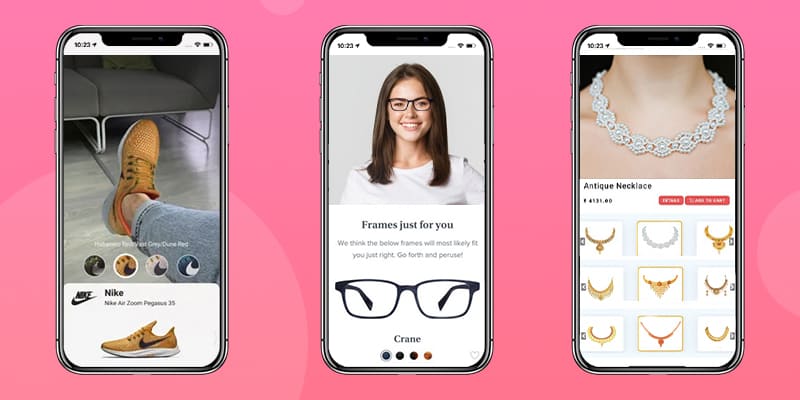
Do you remember when SnapChat first opened wide the world of filters for its users back in 2011? Now, these filters have become the lifeline of myriad mobile applications creating new and exciting business opportunities across the globe. These filters are the direct outcome of the immersive technology called Augmented Reality.
As the name suggests, the tech allows developers and businesses to impose computer graphics on reality, i.e., augment reality with additional visual features. The sheer engagement factor of the AR-powered apps and the abundant potential it uncovers make it one of the most compelling markets for exponential future growth.
As per a Statista report, the global market of augmented reality (including mixed and virtual reality) is forecasted to grow up to 300 billion USD by 2024, almost ten times its present status.
What are Augmented Reality Apps?
With such thrilling possibilities for even your business, it becomes imperative for you to know what augmented reality apps are? By definition, these are the revolutionary mobile applications that enhance the virtual image of real-life objects with virtual objects.
In simpler words, they allow the users to have a composite view of the real-life by overlaying on it some computer-generated graphics. This profound but straightforward application of mobile cameras and other sensors has opened a vast world of endless possibilities, where businesses can let users enjoy a look and feel of their products or services before asking them to make a purchase.
To know more about how different businesses use this application of Augmented Reality, let’s first understand a bit more about the technology itself with a brief overview of its different types.
Types of Augmented Reality Apps
Now, you know what Augmented Reality apps are, on the surface, at least, let’s dive a bit deeper to augment our understanding by learning about its different kinds.
How to Create an Augmented Reality App for Your Business?
With such exciting features, AR has brought to the world a new age of innovation. It opens up new possibilities for businesses to not just market their existing products and services better, but also launch some new ones that can create new revenue streams for their businesses.
1. Requirement Analysis
The foremost step in the development of an augmented reality app, you will need to iron out the basics. Understanding the feasibility of your idea and how that can be included to enhance your business model is crucial. When you hire augmented reality app development company, the experts there will evaluate your requirements and create the tech-stack or a list of technologies to be used for the app development. This tech stack will depend on your chosen operating system and the complexity of the app. Once it’s all decided, the analysts will share a tentative timeline for your augmented reality mobile app, the different stages of development, and the overall cost. Then depending on your conditions, they will begin the designing phase of the app.

2. AR App Design
Unlike most other apps, designing the components of an AR app can be quite complex. Here, you’ll not only need a bespoke interface but rather also 3D models and images of your various virtual components.
3. Developing the App
Once all the visual elements are ready, your app is ready to go under the development stage. Again, since the app uses different interactive modules, the development process will also be slightly segmented. It will begin with-
Backend Development
Though it doesn’t matter whether a mobile app uses augmented reality or not, as far as the backend is concerned, it is important to maintain smooth communication with the backend since most AR apps are usually heavy-duty. Based on the project requirements, you can use any of the JSON APIs to transmit data to and fro.
AR Module Development
Developers highly skilled in tools like ARKit, SceneKit, Vuforia, Wikitude, ARCore, etc., will work in this stage to create logic around your augmented reality app’s virtual objects and environments. These logics will then further get refined in the next step.
Mobile Functionality Development
This is the stage where the actual augmented reality app development will get completed. Your concepts and ideas will all be realized here. All the logics will be coded and integrated together for a seamless experience.
4. Quality Analysis
For an app with so many loaded components, it is essential to assure a smooth user experience. Dedicated QA processes on the app are also necessary to ensure that all the different elements would work equally smoothly on all the target devices. This stage is also essential to see that users are able to use the app as you’d conceptualized it to be used. All in all, it is in this stage you will finally be able to say it with complete confidence that you have your own fully functional augmented reality app.
5. Deployment & Maintenance
With the app all ready, it’s time to deploy and publish it on the major app markets. Before doing so, you have to see that you’re well cognizant of all the app market policies and that they’re not in conflict with any of your business ideas. Furthermore, even after publishing the app, make sure you study the user behavior and trends around your target audience to keep your AR app well updated for futuristic expectations.
Also Read: Discover how Virtual Try-On Technology can revolutionize your business by enhancing customer engagement and delivering personalized shopping experiences.
Tools for Building Best Augmented Reality Apps
Futuristic 2022 AR Trends in Different Industries

The high-end Augmented Reality technologies for mobile application development carry the immense potential for businesses in ranging industries. Here is a brief overview of them and their respective potential AR trends.
How will Matellio Help You as a Dedicated AR App Development Company?
With so much untapped potential, Augmented reality apps present some of the most lucrative business opportunities. If you have an idea that can engage and immerse your users, know that you’re sitting on a treasure trove that can transform your business for the better. We at Matellio have all that can be required to develop the best-augmented reality apps. You can easily hire our AR/VR developers or hand over your dream project to us, and we will see to it that the app becomes a successful reality for your business.
We have decades of experience in mobile application development and have created AR apps for some outstanding industry leaders. We know what it takes to create a somewhat indescribable augmented reality app idea into a perfect source of bountiful revenues. What more? Our experts are also skilled in all the arts of app marketing. They can ensure that your brilliant augmented reality app reaches all its potential users with the added advantage of brand positioning. All you need to do to get the ball rolling is fill the form. Our experts will connect the base with you to understand your app idea and give you a free quote with a complete feasibility check.




